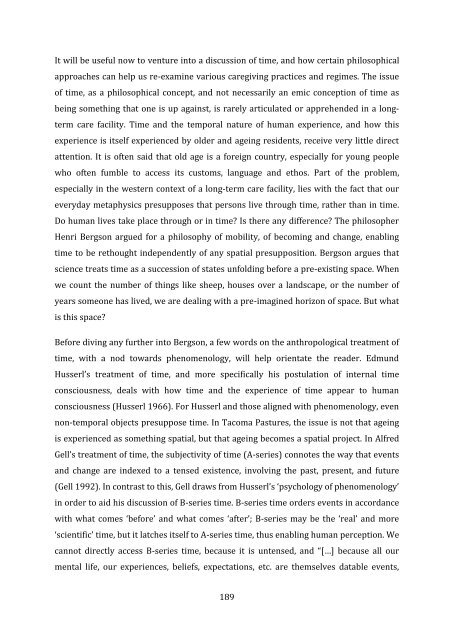Philip Y. Kao PhD thesis - Research@StAndrews:FullText
Philip Y. Kao PhD thesis - Research@StAndrews:FullText
Philip Y. Kao PhD thesis - Research@StAndrews:FullText
You also want an ePaper? Increase the reach of your titles
YUMPU automatically turns print PDFs into web optimized ePapers that Google loves.
It will be useful now to venture into a discussion of time, and how certain philosophical<br />
approaches can help us re-examine various caregiving practices and regimes. The issue<br />
of time, as a philosophical concept, and not necessarily an emic conception of time as<br />
being something that one is up against, is rarely articulated or apprehended in a longterm<br />
care facility. Time and the temporal nature of human experience, and how this<br />
experience is itself experienced by older and ageing residents, receive very little direct<br />
attention. It is often said that old age is a foreign country, especially for young people<br />
who often fumble to access its customs, language and ethos. Part of the problem,<br />
especially in the western context of a long-term care facility, lies with the fact that our<br />
everyday metaphysics presupposes that persons live through time, rather than in time.<br />
Do human lives take place through or in time? Is there any difference? The philosopher<br />
Henri Bergson argued for a philosophy of mobility, of becoming and change, enabling<br />
time to be rethought independently of any spatial presupposition. Bergson argues that<br />
science treats time as a succession of states unfolding before a pre-existing space. When<br />
we count the number of things like sheep, houses over a landscape, or the number of<br />
years someone has lived, we are dealing with a pre-imagined horizon of space. But what<br />
is this space?<br />
Before diving any further into Bergson, a few words on the anthropological treatment of<br />
time, with a nod towards phenomenology, will help orientate the reader. Edmund<br />
Husserl’s treatment of time, and more specifically his postulation of internal time<br />
consciousness, deals with how time and the experience of time appear to human<br />
consciousness (Husserl 1966). For Husserl and those aligned with phenomenology, even<br />
non-temporal objects presuppose time. In Tacoma Pastures, the issue is not that ageing<br />
is experienced as something spatial, but that ageing becomes a spatial project. In Alfred<br />
Gell’s treatment of time, the subjectivity of time (A-series) connotes the way that events<br />
and change are indexed to a tensed existence, involving the past, present, and future<br />
(Gell 1992). In contrast to this, Gell draws from Husserl’s ‘psychology of phenomenology’<br />
in order to aid his discussion of B-series time. B-series time orders events in accordance<br />
with what comes ‘before’ and what comes ‘after’; B-series may be the ‘real’ and more<br />
‘scientific’ time, but it latches itself to A-series time, thus enabling human perception. We<br />
cannot directly access B-series time, because it is untensed, and “[…] because all our<br />
mental life, our experiences, beliefs, expectations, etc. are themselves datable events,<br />
189
















